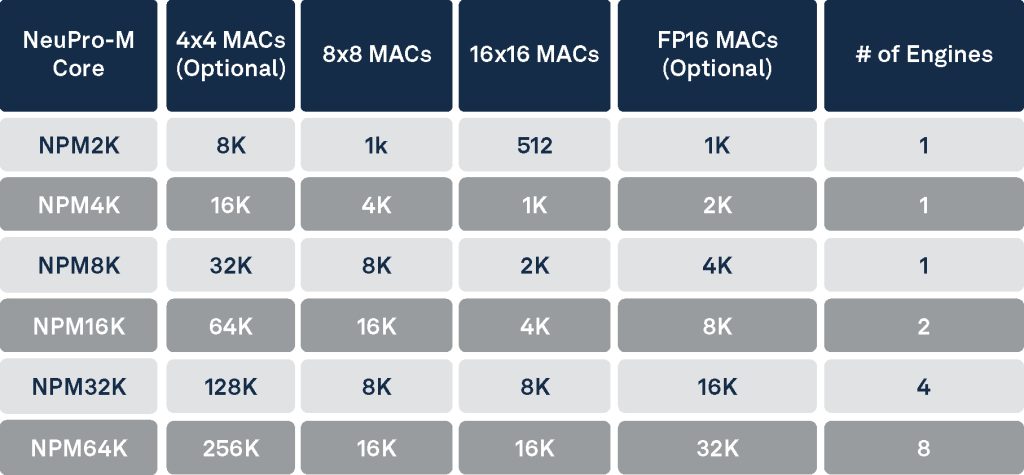- Solutions
- Products
- Resources
-
Company
 Investor Relations
Investor RelationsFinancial Information
- Careers




Ceva-NeuPro-M is a scalable NPU architecture, ideal for transformers, Vision Transformers (ViT), and generative AI applications, with an exceptional power efficiency of up to 3500 Tokens-per-Second/Watt for a Llama 2 and 3.2 models
The Ceva-NeuPro-M Neural Processing Unit (NPU) IP family delivers exceptional energy efficiency tailored for edge computing and cloud inference while offering scalable performance to handle AI models with over a billion parameters. Its innovative architecture, which has won multiple awards, introduces significant advancements in power efficiency and area optimization, enabling it to support massive machine-learning networks, advanced language and vision models, and multi-modal generative AI. With a processing range of 2 to 256 TOPs per core and leading area efficiency, the Ceva-NeuPro-M optimizes key AI models seamlessly. A robust tool suite complements the NPU by streamlining hardware implementation, model optimization, and runtime module composition.
Related Markets
- Consumer IoT
- Automotive
-
Infrastructure
- Mobile
- PC
- Cloud inference
The Solution
The Ceva-NeuPro-M NPU IP family is a highly scalable, complete hardware and software IP solution for embedding high performance AI processing in SoCs across a wide range of edge and cloud AI applications.
The heart of the NeuPro-M NPU architecture is the computational unit. Scalable from 2 to 32 TOPs, a single computational unit comprises a multiple-MAC parallel neural computing engine, activation and sparsity control units, an independent programable vector-processing unit, plus local shared L1 memory and a local unit controller. A core may contain up to eight of these computational units, along with a shared Common Subsystem comprising functional-safety, data-compression, shared L2 memory, and system interfaces.
These NPU cores may be grouped into multi-core clusters to reach performance levels of thousands of TOPs

Benefits
The Ceva-NeuPro-M NPU family empowers edge AI and cloud inference system developers with the computing power and energy efficiency needed to implement complex AI workloads. It enables seamless deployment of multi-modal models and transformers in edge AI SoCs, delivering scalable performance for real-time, on-device processing with enhanced flexibility and efficiency and to cloud inference data bases.
The family can scale from smaller systems, for such applications as security cameras, robotics, or IoT devices, with performance starting at 2 TOPS, to thousands of TOPs of multi-core systems capable of LLM and multi-modal generative AI, all using the same hardware units, core structure, and AI software stack.
Equally important, NeuPro-M provides direct hardware support for vital model optimizations, including variable precision for weights and hardware-supported addressing of sparse arrays. An independent vector processor on each computational unit supports novel computations that might be required in future AI algorithms. The family also provides hardware support for functional safety ISO 26262 ASIL-B.
With its enormous scalability and the Ceva-NeuPro Studio full AI software stack, the Ceva-NeuPro-M family is the fastest route to a shippable implementation for an edge-AI chip or SoC.

Key Features
- Performance and Efficiency
- Scalable Architecture: Independent, fully parallel computing design scalable from 2 TOPs to thousands of TOPs in multi-core configurations, achieving up to 5500 tokens/second.
- Power Efficiency: Exceptional intrinsic hardware efficiency delivering 1500 tokens/second per Watt for optimal energy consumption.
- Dynamic Precision Control: Hardware support for variable weight precision ranging from 16-bit floating point to 4-bit integer, reducing memory requirements, bandwidth usage, and computational energy consumption. Additionally, the system supports mixed precision configurations, including 4×4, 4×8, 4×16, 8×8, and 8×16, enabling optimized performance and flexibility for diverse computational needs.
- Advanced Optimization Techniques
- Quantization Excellence: Advanced quantization techniques like Group Quantization, SpinQuant, and FlatQuant optimize model performance for GenAI, large language models (LLMs) and multi-modal AI. These techniques ensure high accuracy while significantly reducing memory and computational demands, enabling efficient inference for complex, high-parameter AI workloads.
- Sparsity and Activation Engines: Eliminates unnecessary memory and compute cycles, boosting overall efficiency.
- Compression: Optional integrated compression and decompression for weights to minimize memory size and bandwidth usage.
- Future-Proof Design
- Programmable Vector Processor: Provides adaptability for emerging AI algorithms, ensuring long-term hardware relevance in a rapidly evolving AI landscape.
- System integration and integrity – seamless integration through robust interfaces, modular architecture, and adherence to industry standards. It prioritizes data integrity with error-checking mechanisms, ensuring consistent performance and compatibility.
- Functional safety compliance to ISO 26262 ASIL-B
- Integrated AXI matrix optimized for the Ceva-NeuPro-M parallel architecture
- Full AI software stack including Ceva-NeuPro Studio for composing runtime modules
- Compatibility with open-source AI frameworks, including TVM and ONNX



